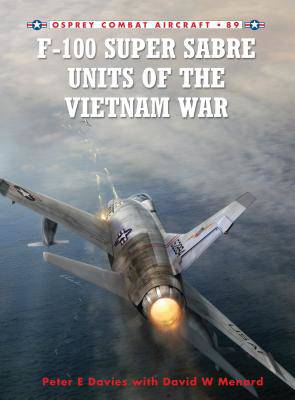
Je cadeautjes zeker op tijd in huis hebben voor de feestdagen? Kom langs in onze winkels en vind het perfecte geschenk!
- Afhalen na 1 uur in een winkel met voorraad
- Gratis thuislevering in België vanaf € 30
- Ruim aanbod met 7 miljoen producten
Je cadeautjes zeker op tijd in huis hebben voor de feestdagen? Kom langs in onze winkels en vind het perfecte geschenk!
- Afhalen na 1 uur in een winkel met voorraad
- Gratis thuislevering in België vanaf € 30
- Ruim aanbod met 7 miljoen producten
Zoeken
Omschrijving
Osprey's examination of the F-100 Super Sabre Units' participation in the Vietnam War (1955-1975). While the F-105 Thunderchief and F-4 Phantom flew the majority of the fighter-bomber missions over North Vietnam, the Thunderchief's service predecessor, the F-100 Super Sabre stayed on to fight the air war in South Vietnam until June 1971. Although it was designed as an air defence fighter, and was later given nuclear capability as the mainstay of Tactical Air Command's deterrent posture, it was the F-100's toughness, adaptability and reliability that made it ideally suited to the incessant 'taxi-rank' close support and counter-insurgency missions in Vietnam. The jet's four 20 mm cannon and external loads of bombs, rockets and fire-bombs defeated many enemy incursions, with US troops in contact expressing a preference for the accuracy and skill of F-100 pilots to save them in situations where ordnance had to be dropped very close to their own lines. Many courageous deeds were performed, although 242 F-100s and 87aircrew were lost in action. Used at the start of Operation Rolling Thunder in March 1965 as an escort for F-105 strikes, the Super Sabre fought MiGs and one pilot made a credible claim for a MiG-17 destroyed, but the more capable F-4 Phantom II soon replaced it in this role. The air-to-ground war was fought by F-100C/D/F pilots from 21 TAC and Air National Guard squadrons at six bases in South Vietnam and Thailand. From September 1965, a number of two-seat F-100Fs were equipped to detect and pinpoint SA-2 missile sites, and they led F-105s in to destroy them in hazardous missions that founded the suppression of enemy air defences (SEAD) techniques developed for F-105F and F-4C 'Wild Weasel' aircraft later in the war. Other F-100Fs replaced fragile piston-engined forward air control (FAC) aircraft, providing more survivable high-speed airborne management of strike missions. Maj George Day, awarded the Medal of Honor in 1973, was the first leader of this 'Misty FAC' unit. The aircraft's strengths and eccentricities will be examined through analysis of its performance and the anecdotes of those who flew and serviced it.
Specificaties
Betrokkenen
- Auteur(s):
- Illustrator(s):
- Uitgeverij:
Inhoud
- Aantal bladzijden:
- 96
- Taal:
- Engels
- Reeks:
- Reeksnummer:
- nr. 89
Eigenschappen
- Productcode (EAN):
- 9781849084468
- Verschijningsdatum:
- 23/08/2011
- Uitvoering:
- Paperback
- Formaat:
- Trade paperback (VS)
- Afmetingen:
- 183 mm x 244 mm
- Gewicht:
- 317 g

Alleen bij Standaard Boekhandel
+ 50 punten op je klantenkaart van Standaard Boekhandel
Beoordelingen
We publiceren alleen reviews die voldoen aan de voorwaarden voor reviews. Bekijk onze voorwaarden voor reviews.









